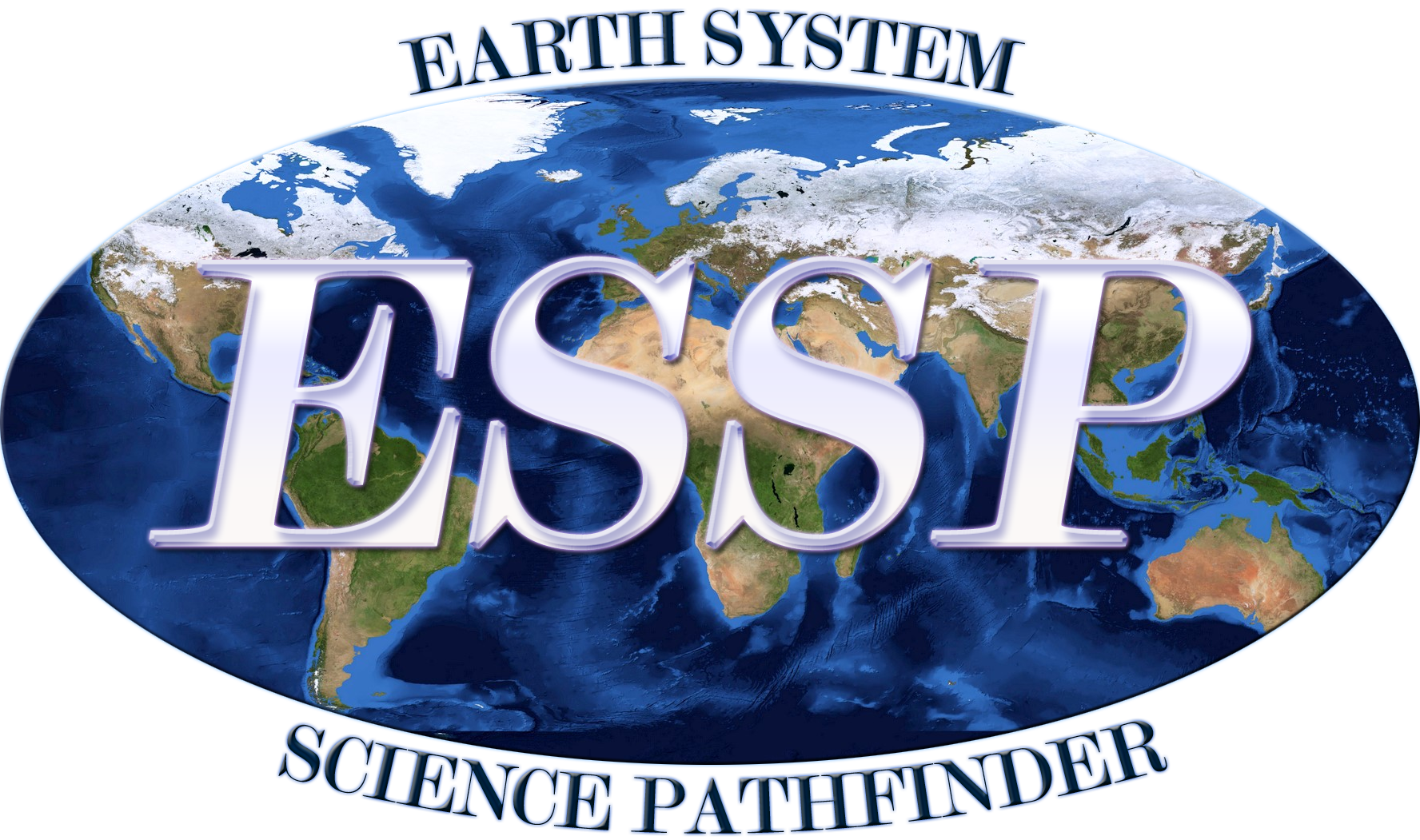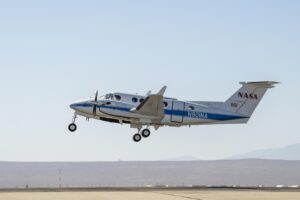by: Bermuda Institute of Ocean Sciences
Archive | 1×1 RSS
TEMPO Air Pollution Sensor Integrated with Satellite Host
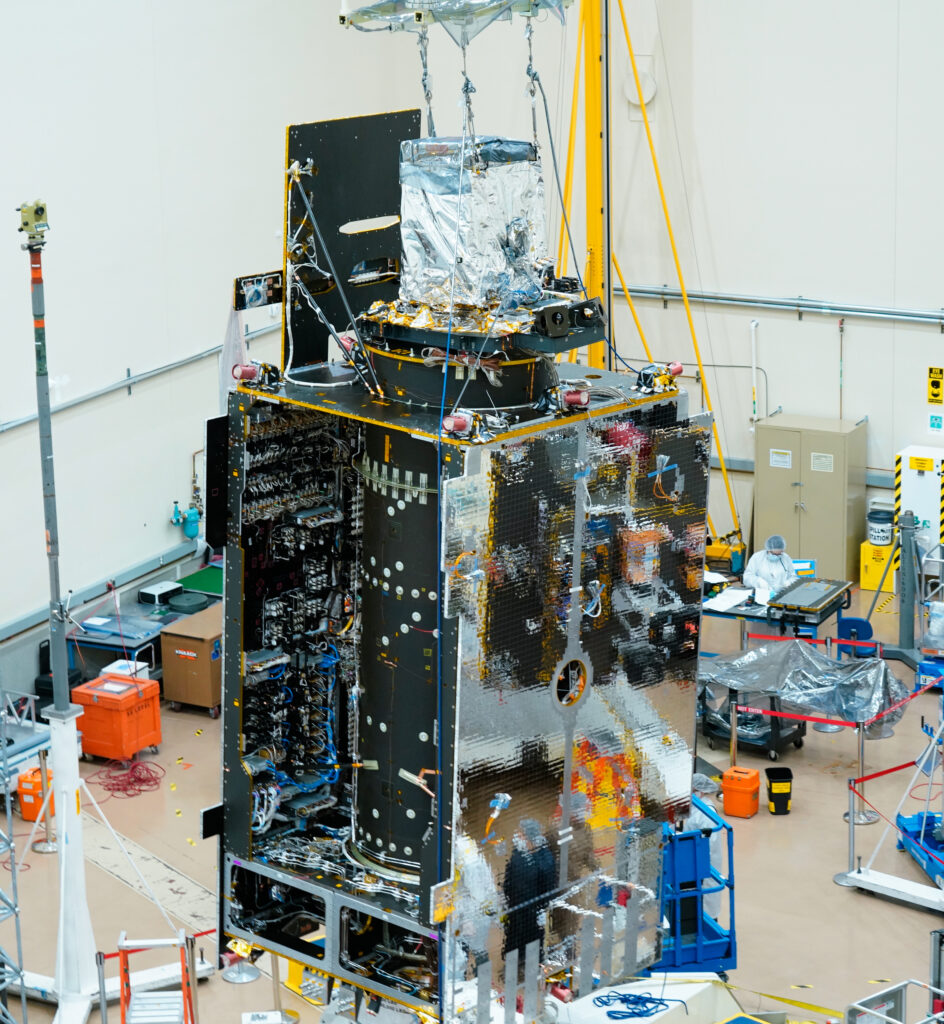
Credits: Image courtesy of Maxar
An air quality sensor that will dramatically improve the way scientists measure air pollution over North America has been joined with its satellite host.
NASA’s Tropospheric Emissions: Monitoring of Pollution (TEMPO) instrument was integrated with Intelsat 40e by Maxar’s Space Program Delivery team in Palo Alto, California. From its geostationary orbit — a high Earth orbit that allows satellites to match Earth’s rotation — TEMPO will take hourly daytime observations of air quality over an area that extends from Puerto Rico to northern Canada, from the Atlantic to the Pacific, encompassing the entire continental United States.
“Because of the hard work and dedication of the entire TEMPO team including our Maxar, Intelsat, and Ball Aerospace partners, we are excited to have completed this significant step toward launching with the IS40e spacecraft ” said Kevin Daugherty, TEMPO project manager at NASA’s Langley Research Center in Hampton, Virginia. “We are looking forward to completing the instrument integration and spacecraft testing in the coming months bringing us closer to delivery of TEMPO’s critical air quality science.”
Air pollution — including ozone, nitrogen dioxide and formaldehyde, and tiny atmospheric particles called aerosols — can have serious consequences for human health and the environment.
Currently scheduled to launch in 2022, TEMPO will also form part of an air quality satellite “virtual constellation” that will offer a more holistic view of how pollution is transported around the Northern Hemisphere. Ball Aerospace in Broomfield, Colorado built the TEMPO instrument.
Kelly Chance, of the Smithsonian Astrophysical Observatory in Cambridge, Massachusetts, is the principal investigator for TEMPO.
NASA Langley Research Center Last Updated: Dec 1, 2021 Editor: Joe Atkinson
https://www.nasa.gov/feature/langley/tempo-air-pollution-sensor-integrated-with-satellite-host
Preparing for Landing: NASA’s S-MODE Wraps up Last Week of Experiments
By Dragana Perkovic-Martin, Principal Investigator for DopplerScatt at NASA’s Jet Propulsion Laboratory // SOUTHERN CALIFORNIA //
11/02/21
Yesterday was a hard down day for the team – everyone needed a rest after a very active week before. The hard down days are in NASA airborne rules and ensure that fatigue does not set in and keep everyone’s safety the top priority.
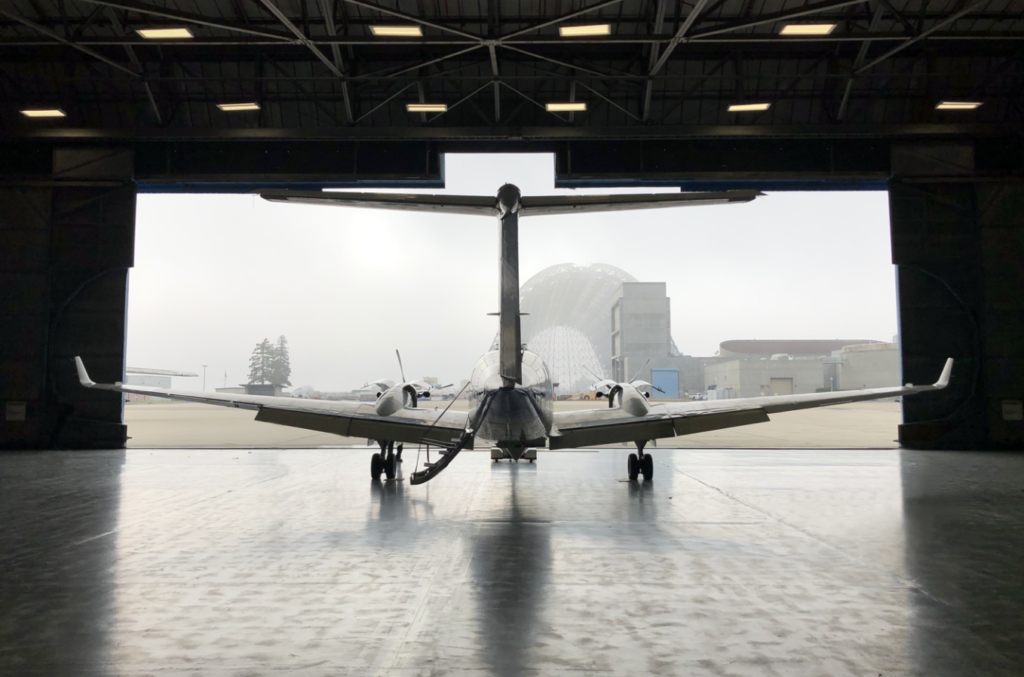
Spooky! NASA King Air B200 and the early morning fog at NASA Ames Research Center. Photo credit: Alex Wineteer / NASA JPL
To fly or not to fly … Today is supposed to be a good day for optical measurements but the pesky fog is really not willing to leave the area of S-MODE operations. We sit and wait for updates from the ship, satellite imagery and forecasts. In the meantime, we are using the Saildrone measurements of wind speed in the area of interest to determine if it’s worthwhile to operate DopplerScatt. The winds are very low. The hourly reports are telling us that the winds have been below DopplerScatt’s threshold for the whole morning, reporting wind speeds of one meter per second. At this wind speed the ocean surface is very still, so still that it may look like a mirror. This is bad news for radar signals bouncing off the surface as their strength depends on the surface roughness. No dice for DopplerScatt today, and the same decision was made for the MOSES and MASS instruments on the Twin Otter.
11/03/21
Remember that pesky problem with the monitor from last week? I overnighted a replacement monitor for the DopplerScatt team since yesterday was a doozy with no flights, they decided to swap out the monitor and keyboard on the plane. Trouble is they did not test that it worked. We just thought, “well what could go wrong, it’s the same model.” What do you know, it did go wrong! I’ll spare you the details and the frantic messaging between myself and the operators, but after some time they realized that the power cable was not plugged in and the monitor was not getting power. All in a day of DopplerScatt deployments!

Crew of the day from left to right: Karthik Srinivasan (JPL DopplerScatt operator), Hernan Posada (AFRC pilot), Jeroen Molemaker (UCLA MOSES operator), James Less (AFRC pilot). Photo credit: Alex Wineteer / NASA JPL
11/04/21
Today is a science extravaganza! We have a big day ahead of us with two NASA King Air B200 flights planned and all of the in-water assets sampling data throughout the day. The weather is finally cooperating and we have a clear yet windy day ahead of us. The plan today is to fly a morning flight – which just took off at 8am – and then another one leaving approximately 6 hours later and flying the exact same pattern. The comparison of data between the two will tell us about the daily variability of the ocean processes.
“This is one of the reasons why I am so excited about S-MODE,” said Hector Torres, DopplerScatt team member, operator and one of the main people responsible for simulating ocean processes. “The results based on theory and numerical simulations produced in the last five years are about to get confirmed or debunked today. Either way it will be a breakthrough!”
Flight one is now done! There were some pesky low clouds right in the area of collection that prevented MOSES from collecting quality data for half of the flight, but the second half was great. DopplerScatt data collection went as planned and data are churning already! We are seeing the first quick look data products trickle in as we watch the afternoon flight take off.
While the first flight was a bit difficult for our optical colleague running the MOSES system, Jeroen Molemaker from the University of California, Los Angeles, the afternoon was gloriously clear and provided a great opportunity for all airborne instruments to collect data at the same time.

Quick look composite image of the sea surface temperature as observed by the MOSES instrument on the November 4, 2021 afternoon flight. The tracks are overlaid on DopplerScatt derived surface current velocities from the morning flight, showing the spatial relationship between currents and density fields. The color scale blue to red has a range of 2°C. Credit: NASA’s S-MODE team / Jeroen Molemaker
Today the S-MODE pilot experiment operated as we envisioned many months ago, with all platforms sampling data throughout the day over the area of interest. The field experiment crew is tired but happy and the team is excited about the science that we will extract from this data set.
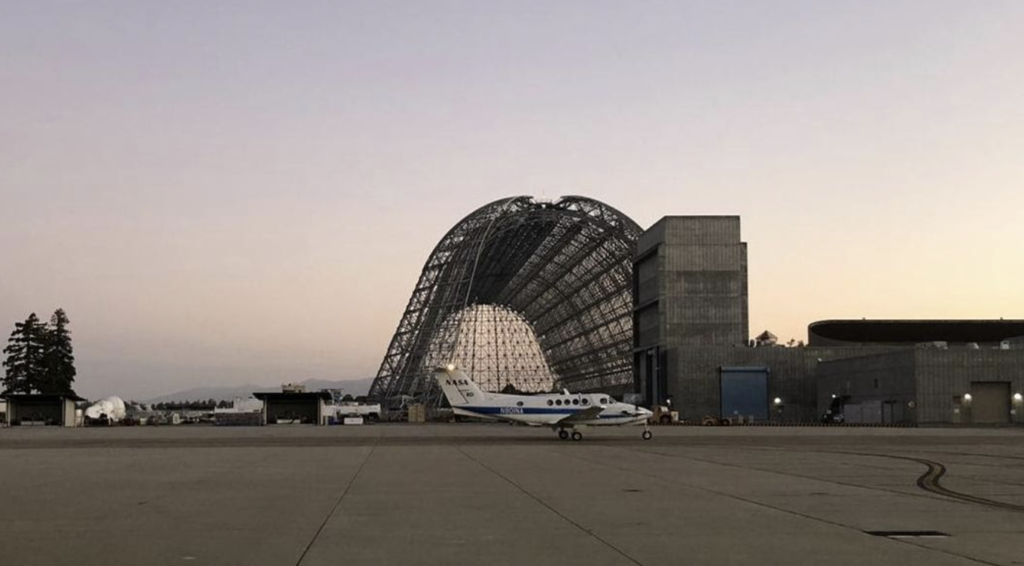
Goodnight moon. NASA King Air B200 on arrival at Moffett Field, California after a long day of flights. Photo credit: Alex Wineteer / NASA Jet Propulsion Laboratory
11/05/21
Today is the final day of the S-MODE pilot campaign. It’s a bittersweet feeling for me as it was so much fun to collaborate and coordinate daily activities with so many people. I will miss that, but I certainly will not miss the hectic calls of “we have a problem with …”
The NASA King Air B200 will fly in the afternoon collecting data in the western region of the S-MODE study area together with the Twin Otter aircraft. Meanwhile, our friends on the ship will start recovering the autonomous assets and make their way toward Newport, Oregon.
Trouble struck again as our GPS unit could not get itself aligned and produce a good navigation solution, requiring a power reset and making S-turns i.e. banking the aircraft left and right in succession. After this excitement things went smoothly for the rest of the flight. You never know what will go wrong during a field deployment, you just know that something will and you need to be prepared to react and fix things without letting the panic set in! Thankfully that is what happened today thanks to Alex Winteer, a DopplerScatt operator from NASA JPL. He performed a cool and collected power reset while in air!
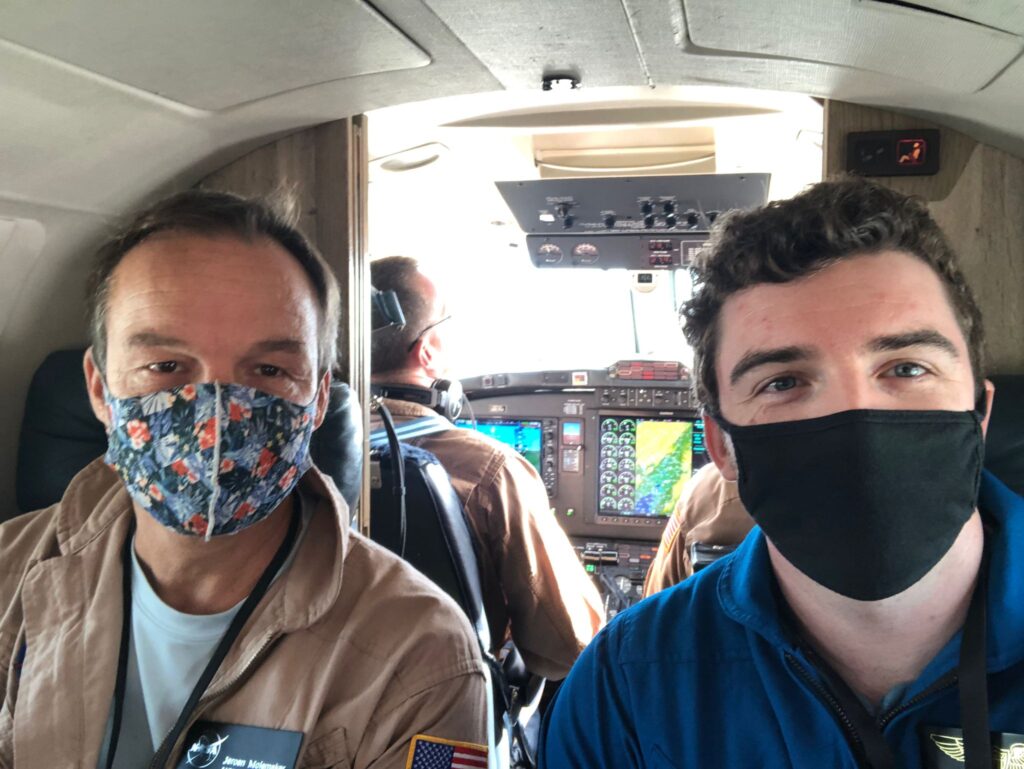
Happy crew on their last flight of the S-MODE pilot campaign. On the left is Jeroen Molemaker (UCLA MOSES operator) and on the right is Alex Wineteer (JPL DopplerScatt operator). Photo credit: Karthik Srinivasan / NASA JPL
Now it is time to work on our post-deployment to do list and eagerly await results of data processing.
I will leave you with two short blurbs from DopplerScatt team members Alex and Karthik about their impressions of the pilot campaign.
“On most days, you don’t wake up looking forward to a boring day. As an instrument operator, a boring day during a deployment, however, is a different story. You look forward to sitting in a small round aluminum tube for 4.5 hours with nothing to do. That is a perfect day – a day when the radar just works. No last minute excitement of monitors not turning on (because someone unplugged it and forgot to plug it back in!) or the satellite phone connection not working. While the entire science team is excited about an action-packed day of coincident data collection, all the instrument operators look forward to is a day where everything just works as it should! Of course, sitting in an aluminum tube for many hours, staring out at the ocean with nothing to do makes you yearn for some excitement, but that is a fleeting thought until you get a text message via satellite link asking you to pay attention to the speed of the aircraft!”
– Karthik Srinivasan, NASA JPL DopplerScatt operator
“I’ve been on quite a few field deployments with DopplerScatt, but none quite as exciting – or as important—as this one. Indeed, such a coordinated effort consisting of multiple aircraft and many assets in the water has never been attempted, and the resulting science will lead to new understanding of our ocean, atmosphere and the climate system as a whole. On Thursday, we attempted two flights for the first time. I operated the first flight: crew brief at 6:30 AM with a takeoff time of 8 AM. Thankfully, our instrument operated normally, and we were able to fly a bit lower –under the clouds – to ensure MOSES could see the ocean surface with its infrared camera. We landed five hours later, at around 1 PM, and I immediately took our data back to our field processing center in the aircraft hangar to start crunching. In the meantime, Karthik took off for our second flight of the day. By the time I finished the first round of processing, it was 5 PM and Karthik was almost back from the second flight, so I went downstairs to welcome him back (and grab the data!). A few hours later, we had both flights processed to quick look data products and I was exhausted. Being just one person, a small part of a much larger mission, it can be easy to lose sight of why we do this, especially when the hours are long. But when the data started pouring in, my exhaustion was quickly replaced by excitement. We were seeing a dataset no one had ever seen before. With these two flights, we are able to not just see the sub-mesoscale structure of the ocean surface over a large area, but we could also see its evolution over time and how the atmosphere interacts with that evolution! There is much work to go in analyzing these data, especially in comparing the many other instruments to our DopplerScatt measurements, but I am grateful to play a part in that analysis, discovery and understanding.”
– Alex Wineteer, NASA JPL DopplerScatt operator
NASA Selects New Mission to Study Storms, Impacts on Climate Models
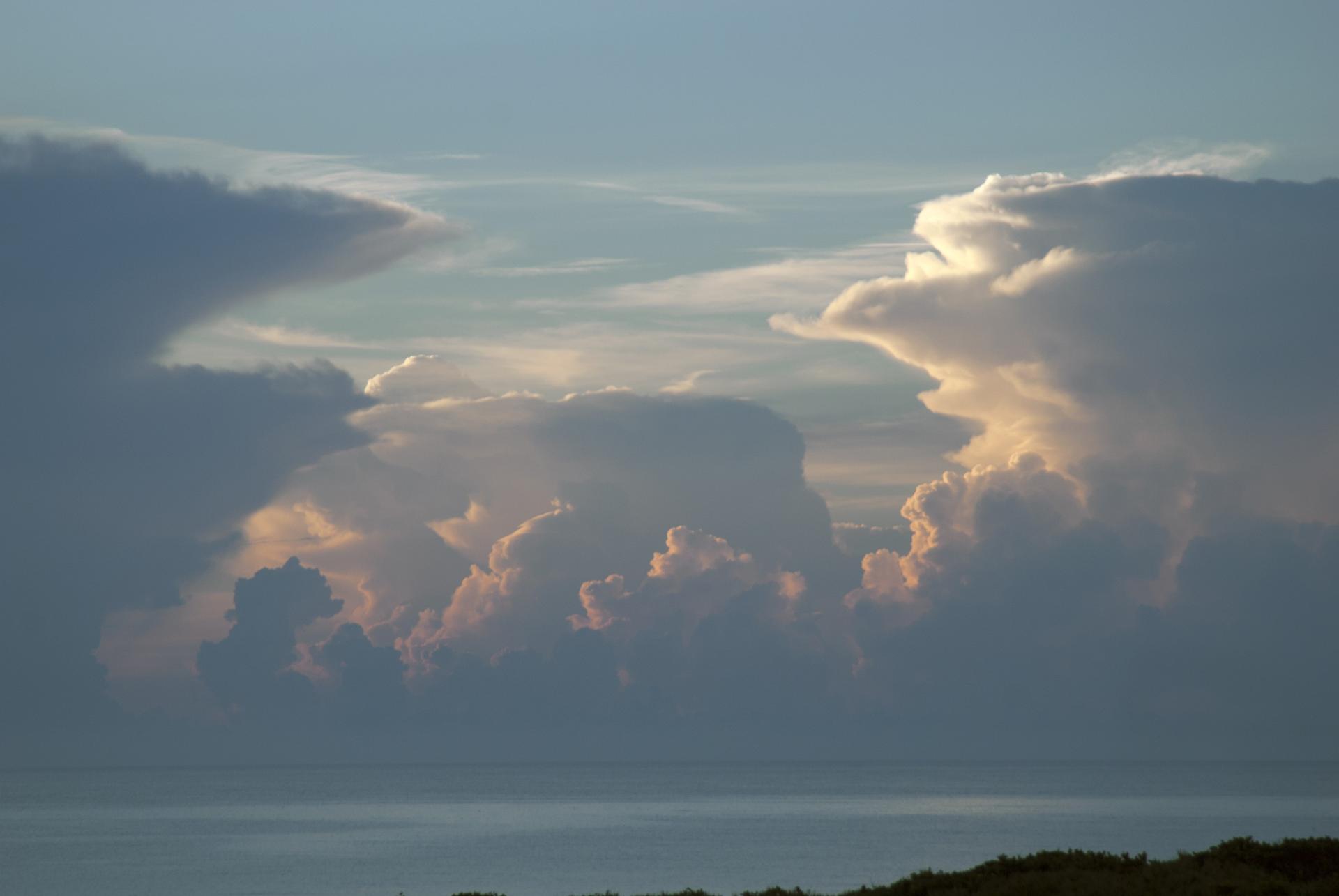
NASA has selected a new Earth science mission that will study the behavior of tropical storms and thunderstorms, including their impacts on weather and climate models. The mission will be a collection of three SmallSats, flying in tight coordination, called Investigation of Convective Updrafts (INCUS), and is expected to launch in 2027 as part of NASA’s Earth Venture Program.
NASA selected INCUS through the agency’s Earth Venture Mission-3 (EVM-3) solicitation that sought complete, space-based investigations to address important science questions and produce data of societal relevance within the Earth science field. NASA received 12 proposals for EVM-3 missions in March 2021. After detailed review by panels of scientists and engineers, the agency selected INCUS to continue into development.
“Every one of our Earth science missions is carefully chosen to add to a robust portfolio of research about the planet we live on,” said Thomas Zurbuchen, associate administrator for the agency’s Science Mission Directorate in Washington. “INCUS fills an important niche to help us understand extreme weather and its impact on climate models – all of which serves to provide crucial information needed to mitigate weather and climate effects on our communities.”
INCUS aims to directly address why convective storms, heavy precipitation, and clouds occur exactly when and where they form. The investigation stems from the 2017 Earth Science Decadal Survey by the National Academies of Sciences, Engineering, and Medicine, which lays out ambitious, but critically necessary, research and observation guidance.
“In a changing climate, more accurate information about how storms develop and intensify can help improve weather models and our ability to predict risk of extreme weather,” said Karen St. Germain, NASA’s Earth Science division director. “This information not only deepens our scientific understanding about the changing Earth processes, but can help inform communities around the world.”
Climate change is increasing the heat in the oceans and making it more likely that storms will intensify more often and more quickly, a phenomenon NASA scientists continue to study.
Storms begin with rapidly rising water vapor and air that create towering clouds primed to produce rain, hail, and lighting. The greater the mass of water vapor and air that is transported upward in the atmosphere, the higher the risk of extreme weather. This vertical transport of air and water vapor, known as convective mass flux (CMF), remains one of the great unknowns in weather and climate. Systematic CMF measurements over the full range of conditions would improve the representation of storm intensity and constrain high cloud feedbacks – which can add uncertainty – in weather and climate models.
The principal investigator for INCUS is Susan van den Heever at Colorado State University in Fort Collins. The mission will be supported by several NASA centers including the Jet Propulsion Laboratory in Southern California, Goddard Space Flight Center in Greenbelt, Maryland, Marshall Space Flight Center in Huntsville, Alabama, with key satellite system components to be provided by Blue Canyon Technologies, and Tendeg LLC, both in Colorado. The mission will cost approximately $177 million, not including launch costs. NASA will select a launch provider in the future.
NASA’s Earth Venture Program consists of science-driven, competitively selected, low-cost missions/investigations. This program provides opportunities for investment in innovative science to enhance our capability to better understand the current state of the Earth system and further improve predictions of future changes. The current Earth Venture program include full missions, satellite instruments for flights of opportunity, instruments for Earth science data record continuity, and sustained suborbital investigations.
For more information about NASA’s Earth science programs, visit: https://www.nasa.gov/earth
Press Contacts
Tylar Greene
Headquarters, Washington
202-358-0030
tylar.j.greene@nasa.gov
NASA’s TROPICS Pathfinder Satellite Produces Global First Light Images and Captures Hurricane Ida

The satellite launched on June 30, 2021 as the pathfinder – or test – satellite for NASA’s Time-Resolved Observations of Precipitation structure and storm Intensity with a Constellation of Smallsats (TROPICS) mission. The Pathfinder satellite provides an opportunity to test the technology, communication systems, and data processing before the six satellites comprising the TROPICS constellation launch in 2022. “[Pathfinder] is like a dress rehearsal of the mission,” said Bill Blackwell, the principal investigator for the TROPICS mission and a researcher at the Massachusetts Institute of Technology Lincoln Laboratory in Lexington, Massachusetts.
The future TROPICS constellation will orbit Earth in three planes, collecting temperature, water vapor, precipitation, and cloud ice measurements on a frequent, near-global scale to study storms and other meteorological events. The idea is that multiple satellites in spread out orbits will collect more frequent measurements around the globe, allowing scientists to study storms as they develop and then use the newly-acquired knowledge to improve forecasting capabilities. The TROPICS research team includes researchers from NASA, the National Oceanic and Atmospheric Administration (NOAA), and several universities and commercial partners.
“Early in the mission, the Pathfinder satellite has already demonstrated the usefulness of this data – especially the images of Hurricane Ida. We’re able to see a lot of features that we want to study with the TROPICS constellation,” said Blackwell.
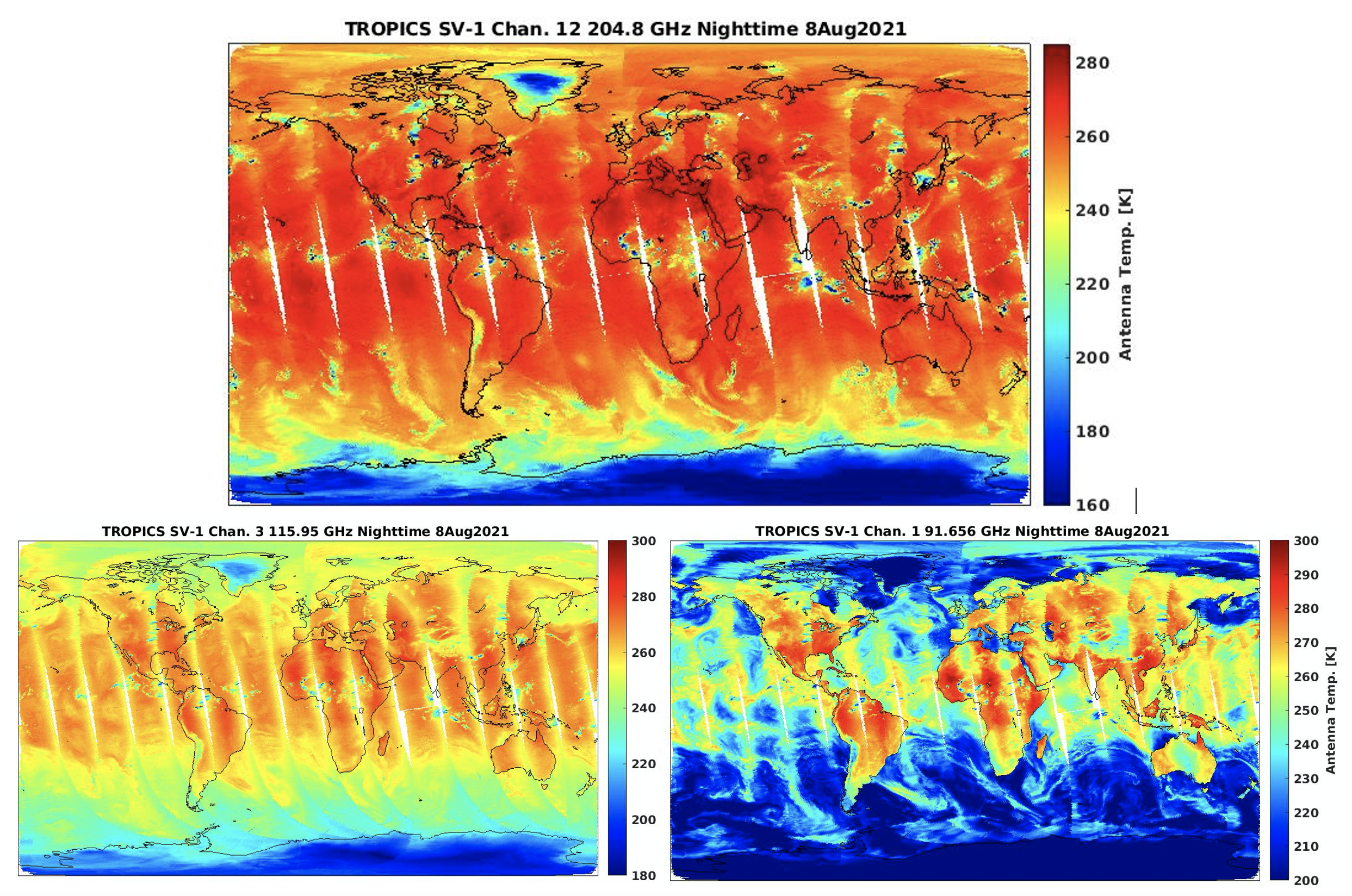
Three images produced by the TROPICS Pathfinder satellite using different frequencies.
The TROPICS Pathfinder satellite captured its first global data on August 8, 2021, including a channel around 205 GHz (top). It’s the first time a frequency higher than 190 GHz has been used on a space-borne microwave cross-track sounder instrument, which collects temperature and water vapor data using microwave radiance observations.
Credits: NASA / TROPICS Pathfinder satellite
The global first light images show microwave data collected at several frequencies, each giving scientists a different piece of the larger puzzle of thermodynamics in Earth’s atmosphere. The image, comprised of 91 GHz data, shows water vapor, including swirls of atmospheric moisture over the ocean. The data from the 115 GHz frequency provides measurements of temperature at Earth’s surface and in the lower atmosphere. The 205 GHz data yields measurements of the precipitation-sized ice particles contained within clouds. “This is the first time we’ve flown a microwave cross-track sounder using that high of a frequency,” said Blackwell. The microwave cross-track sounder is an instrument that collects temperature and water vapor data using microwave radiance observations. “It’s very sensitive to observe ice in the cloud tops, which can give us an indication of the intensity of a storm.”
TROPICS Pathfinder also captured images of Hurricane Ida on August 28 and 29, just before and after the storm made landfall in Louisiana. Read the full story about these images on the NASA Applied Sciences website.
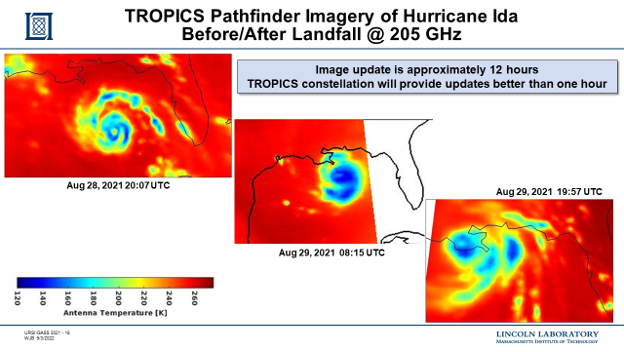
Images of Hurricane Ida before landfall (left) show a well-defined eye of the storm, as well as inner and outer rainbands that persisted as the storm made landfall in Louisiana (right).
Images of Hurricane Ida before landfall (left) show a well-defined eye of the storm, as well as inner and outer rainbands that persisted as the storm made landfall in Louisiana (right).
Credits: NASA / TROPICS Pathfinder satellite
“What the constellation will give us that we don’t have today is higher revisit rates – so we’ll be able to observe storms from space at microwave frequencies much more frequently than we can now,” said Blackwell.
By Sofie Bates
NASA’s Earth Science News Team
Link to original article NASA’s TROPICS Pathfinder Satellite Produces Global First Light Images and Captures Hurricane Ida
Pathfinder Satellite Paves Way for Constellation of Tropical-storm Observers
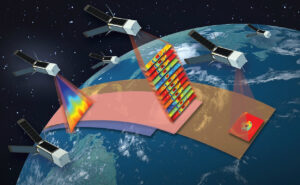
The 2020 Atlantic hurricane season was one of the most brutal on record, producing an unprecedented 30 named storms. What’s more, a record-tying 10 of those storms were characterized as rapidly intensifying — some throttling up by 100 miles per hour in under two days.
To bring more data to forecasters and have a more consistent watch over Earth’s tropical belt where these storms form, NASA has launched a test satellite, or pathfinder, ahead of a constellation of six weather satellites called TROPICS (Time-Resolved Observations of Precipitation structure and storm Intensity with a Constellation of Smallsats). Planned for launch in 2022, the TROPICS satellites will work together to provide near-hourly microwave observations of a storm’s precipitation, temperature, and humidity – a revisit time for these measurements not currently possible with other satellites.
“As a lifelong Floridian, I’ve seen firsthand the devastating impact that hurricanes can have on our communities. And as climate change is making hurricanes even stronger, it’s more important than ever that NASA and our partners invest in missions like TROPICS to better track and understand extreme weather,” said NASA Administrator Bill Nelson. “NASA’s innovation is strengthening data models that help scientists improve storm forecasting and understand the factors that feed these monster storms. TROPICS will help to do just that and we look forward to next year’s launch of the TROPICS satellite constellation.”
When launched, the TROPICS satellites will work together to provide near-hourly microwave observations of a storm’s precipitation, temperature, and humidity. The mission is expected to help scientists understand the factors driving tropical cyclone intensification and to improve forecasting models.Credits: NASA
“TROPICS is the beginning of a new era. This mission will be among the first to use a constellation of small satellites for these types of global, rapid-revisit views of tropical storms,” said Scott Braun, the TROPICS project scientist and a research meteorologist at NASA’s Goddard Space Flight Center in Greenbelt, Maryland.
Since tropical cyclones and hurricanes can change rapidly as they travel across the ocean, the increased observations from the TROPICS satellites will not only advance the science of understanding storm intensity, they also may improve intensity forecasts.
“The project holds great promise to boost NOAA’s steady improvements in weather and hurricane forecasts by feeding new environmental data into our world-class numerical weather prediction models,” said Frank Marks, director of the Hurricane Research Division of NOAA’s Atlantic Oceanographic and Meteorological Laboratory. After all six satellites are launched and positioned in 2022, “this new constellation will provide high frequency temperature and humidity soundings as we seek to learn how hurricanes interact with the surrounding temperature and moisture environment—key data that could improve hurricane intensity forecasts.”
A critical step to preparing for the constellation is the launch of a pathfinder satellite, a seventh identical copy of the TROPICS smallsats, that will enable full testing of the technology, communication systems, data processing, and data flow to application users in advance of the constellation’s launch. This will allow time for adjustments to the ground system and data products, helping ensure the success of the TROPICS mission.
“The TROPICS Pathfinder satellite is similar to a screening before the opening night of a big show,” said Nicholas Zorn, the Pathfinder program manager from MIT Lincoln Laboratory. “Its mission is a real-world, end-to-end test, from environmental verification through integration, launch, ground communications, commissioning, calibration, operations, and science data processing. Any areas for improvement identified along the way can be reinforced before the constellation launches.”
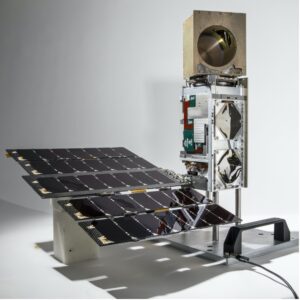
The TROPICS Pathfinder satellite, pictured above, was launched on June 30. The satellite body measures approximately 10 cm X 10 cm X 36 cm and is identical to the six additional satellites that will be launched in the constellation in 2022. The golden cube at the top is the microwave radiometer, which measures the precipitation, temperature, and humidity inside tropical storms.
Credits: Blue Canyon Technologies
MIT Lincoln Laboratory’s William Blackwell is the TROPICS principal investigator. Six years ago, he submitted TROPICS as a proposal to NASA’s Earth Venture Instrument competition series and was awarded funding. The Earth Venture Instrument program calls for innovative, science-driven, cost-effective missions to solve pressing issues related to Earth science.
Aboard each TROPICS small satellite is an instrument called a microwave radiometer, which detects temperature, moisture, and rainfall in the atmosphere. On current weather satellites, microwave radiometers are about the size of a washing machine. On TROPICS’ small satellites the radiometers are about the size of a coffee mug.
Microwave radiometers work by detecting the thermal radiation naturally emitted by oxygen and water vapor in the air. The TROPICS instrument measures these emissions via an antenna spinning at one end of the satellite. The antenna listens in at 12 microwave channels between 90 to 205 gigahertz, where the relevant emission signals are strongest. These channels capture signals at different heights throughout the lowest layer of the atmosphere, or troposphere, where most weather we experience occurs.
By flying the TROPICS radiometers at lower altitude and detecting fewer channels than their larger counterparts, in the channels they do carry, the radiometers deliver comparable performance.
Miniaturizing the microwave radiometer has been an incremental process over the last 10 years for Blackwell and his team, spurred by the invention of CubeSats, satellites the size of a loaf of bread that are often economical to launch. TROPICS builds on Blackwell and his team’s 2018 success in launching the first microwave radiometer on a CubeSat to collect atmospheric profiling data. The instrument aboard the TROPICS’ six satellites has been upgraded to provide improved sensitivity, resolution and reliability and will make more targeted and rapid weather observations.
“These storms affect a lot of people, and we expect that with the increased observations over a single storm from TROPICS, we will be able to improve forecasts, which translates to helping people get to safety sooner, protect property, and overall enhance the national economy,” Blackwell says, looking ahead to the full constellation launch next year. “It is amazing technology that we have proven out that allows us to maximize the science from the instrument’s size factor. To pull this off has taken contributions of so many people.”
The TROPICS science team includes researchers from MIT Lincoln Laboratory and MIT Department of Aeronautics and Astronautics; NASA’s Goddard Space Flight Center; NOAA Atlantic Oceanographic and Meteorological Laboratory; NOAA National Hurricane Center; NOAA National Environmental Satellite, Data, and Information Service; University of Miami; Colorado State University; Vanderbilt University; and University of Wisconsin. The University of Massachusetts Amherst, Texas A&M University and Tufts University contributed to the technology development. Maverick Space Systems provided integration services for the Pathfinder, which was launched from SpaceX’s Transporter 2 mission. Astra Space Inc. is providing launch services for the constellation. NASA’s Launch Services Program based at Kennedy Space Center procured and is managing the Tropics Pathfinder launch service.
By Kylie Foy
Massachusetts Institute of Technology, Lincoln Laboratory
NASA Media Contact: Ellen Gray, Earth Science News Team
WIRED Magazine Article -“Tiny Satellites Could Help Warn of the Next Big Hurricane”
WIRED Magazine published a fantastic article explaining the importance of TROPICS and key science and societal benefit that TROPICS and the Pathfinder will be conducting once on orbit. The following is the link to the article by Meghan Herbst
TEMPO Air Pollution Sensor Treks Toward Satellite Integration
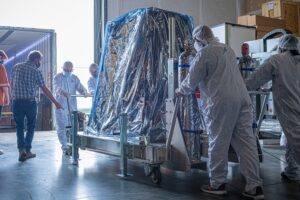
A crew at Ball Aerospace in Broomfield, Colorado, rolls the TEMPO satellite instrument onto a truck for shipment to Maxar Technologies’ satellite manufacturing facility in Palo Alto, California.
Credits: Ball Aerospace
A NASA satellite instrument that will measure air pollution over North America has reached another key project milestone. On Tuesday, May 18, The Tropospheric Emissions: Monitoring of Pollution (TEMPO), instrument, which will take hourly daytime measurements at an unprecedented spatial resolution shipped from Ball Aerospace in Broomfield, Colorado, to Maxar Technologies’ satellite manufacturing facility in Palo Alto, California, for integration onto the Intelsat 40e.
Ball completed building TEMPO in 2018. After its scheduled launch in 2022, the TEMPO instrument will make measurements of air pollution —including ozone, nitrogen dioxide and formaldehyde, and tiny atmospheric particles called aerosols — that can damage human health and the environment. Those measurements will reach from Puerto Rico and Mexico to northern Canada, and from the Atlantic to the Pacific, encompassing the entire lower 48 United States.
“This is an exciting time for the mission,” said Kevin Daugherty, TEMPO project manager at NASA’s Langley Research Center in Hampton, Virginia. “We are about to begin integrating the TEMPO instrument with our host satellite and undergo testing to ensure the satellite can survive the launch and environment of space prior to being launched into space.”
From its geostationary orbit — a high Earth orbit that allows satellites to match Earth’s rotation — TEMPO will also form part of an air quality satellite “virtual constellation” that will track pollution around the Northern Hemisphere. South Korea’s Geostationary Environment Monitoring Spectrometer (GEMS), the first instrument in the constellation, launched into space last year on the Korean Aerospace Research Institute GEO-KOMPSAT-2B satellite, and is measuring pollution over Asia. The European Space Agency Sentinel-4 satellite, expected to launch in 2023, will make measurements over Europe and North Africa.
Kelly Chance, of the Smithsonian Astrophysical Observatory in Cambridge, Massachusetts, is the principal investigator for TEMPO.
— NASA Langley Research Center
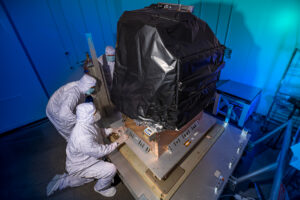
Credit: Joe Atkinson
link to original article TEMPO Air Pollution Sensor Treks Toward Satellite Integration
NASA’s S-MODE Takes to the Air and Sea to Study Ocean Eddies
After being delayed over a year due to the pandemic, a NASA field campaign to study the role of small-scale whirlpools and ocean currents in climate change is taking flight and taking to the seas in May 2021.
Using scientific instruments aboard a self-propelled ocean glider and several airplanes, this first deployment of the Sub-Mesoscale Ocean Dynamics Experiment (S-MODE) mission will deploy its suite of water- and air-borne instruments to ensure that they work together to show what’s happening just below the ocean’s surface. The full-fledged field campaign will begin in October 2021, with the aircraft based out of NASA’s Ames Research Center in Mountain View, California.
“This campaign in May is largely to compare different ways of measuring ocean surface currents so that we can have confidence in those measurements when we get to the pilot in October,” said Tom Farrar, associate scientist at the Woods Hole Oceanographic Institution in Massachusetts and principal investigator for S-MODE.
The S-MODE team hopes to learn more about small-scale movements of ocean water such as eddies. These whirlpools span about 6.2 miles or ten kilometers, slowly moving ocean water in a swirling pattern. Scientists think that these eddies play an important role in moving heat from the surface to the ocean layers below, and vice versa. In addition, the eddies may play a role in the exchange of heat, gases and nutrients between the ocean and Earth’s atmosphere. Understanding these small-scale eddies will help scientists better understand how Earth’s oceans slow down global climate change.
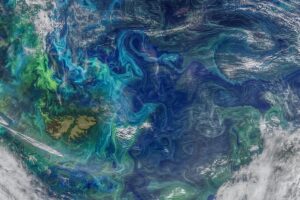
Sub-mesoscale ocean dynamics, like eddies and small currents, are responsible for the swirling pattern of these phytoplankton blooms (shown in green and light blue) in the South Atlantic Ocean on Jan. 5, 2021.
Credits: NASA’s Goddard Space Flight Center Ocean Color, using data from the NOAA-20 satellite and the joint NASA-NOAA Suomi NPP satellite.
A Self-Powered Surfboard, for Science!
The team is using a self-propelled commercial Wave Glider decked out with scientific instruments that can study the ocean from its surface. The most important gadgets aboard are the acoustic Doppler current profilers, which use sonar to measure water speed and gather information about the how fast the currents and eddies are moving, and in which direction. The glider also carries instruments to measure wind speed, air temperature and humidity, water temperature and salinity, and light and infrared radiation from the Sun.
“The wave glider looks like a surfboard with a big venetian blind under it,” said Farrar.
That “venetian blind” is submerged under the water, moving up and down with the ocean’s waves to propel the glider forward at about one mile per hour. In this way, the wave glider will be deployed from La Jolla, California, collecting data as it travels over 62 miles (100 kilometers) out into the ocean offshore of Santa Catalina Island.
Decked out with solar panels and several scientific instruments, the wave glider will propel itself from Santa Catalina Island farther out to sea.

Laurent Grare of the Scripps Institution of Oceanography prepares to recover a Wave Glider during a pre-deployment test. Decked out with solar panels and several scientific instruments, the wave glider will propel itself from Santa Catalina Island farther out to sea.
Credits: Courtesy of Benjamin Greenwood / Woods Hole Oceanographic Institution
The new data will allow the scientists to estimate the exchange of heat and gases between Earth’s atmosphere and the ocean, and consequently better understand global climate change.
“We know the atmosphere is heating up. We know the winds are speeding up. But we don’t really understand where all that energy is going,” said Ernesto Rodriguez, research fellow at NASA’s Jet Propulsion Laboratory in Pasadena, California, and deputy principal investigator for the airborne parts of S-MODE. It’s likely that this energy is going into the ocean, but the details of how that process works are still unknown. The team thinks that small-scale eddies may help move heat from the atmosphere to the deeper layers of the ocean.
Eyes and Scientific Instruments in the Skies
While the Wave Glider continues its slow trek across the ocean’s surface, several airplanes will fly overhead to collect data from a different vantage.
“In an airplane, we can get a snapshot of a large area to see the context of how the bigger- and smaller-scale ocean movements interact,” said Rodriguez.
For example, a ship or wave glider travels slowly along a straight line, taking precise measurements of sea surface temperature at specific times and places. Airplanes move faster and can cover more ground, measuring the sea surface temperature of a large swath of ocean very quickly.
“It’s like taking an infrared image rather than using a thermometer,” explained Farrar.

A flight crew prepares for the B200 King Air Sub-Mesoscale Ocean Dynamics Experiment (S-MODE) at NASA’s Armstrong Flight Research Center in Edwards, California. From left to right are Jeroen Molemaker and Scott “Jelly” Howe.
Two planes will be used in the May test flights: a B200 plane from NASA’s Armstrong Flight Center in Edwards, California and a commercial plane from Twin Otter International. The B200 is carrying an instrument from NASA JPL called DopplerScatt to measure currents and winds near the ocean surface with radar. The Multiscale Observing System of the Ocean Surface (MOSES) instrument from the University of California, Los Angeles is also aboard to collect sea surface temperature data. On the Twin Otter plane is the Modular Aerial Sensing System (MASS) from the Scripps Institution of Oceanography at the University of California, San Diego, which is an instrument capable of measuring the height of waves on the surface of the ocean.

Delphine Hypolite, Multiscale Observing System of the Ocean Surface (MOSES) Operator from University of California Los Angeles, performs pre-flight checks on the MOSES Camera System at NASA’s Armstrong Flight Research Center in Edwards, California.
The fleet will gain a third member for the October experiments: NASA’s Langley Research Center Gulfstream III plane with JPL’s Portable Remote Imaging SpectroMeter (PRISM), an instrument to measure phytoplankton and other biological material in the water. The October deployments will also use a large ship and some autonomous sailing vessels, called Saildrones, in addition to planes and Wave Gliders.
After nearly a year and a half of delays due to the pandemic, the S-MODE team is excited to get their planes in the sky and the gliders in the water. “It was frustrating,” Rodriguez said, “but the science team hasn’t slowed down. The science keeps progressing.”
S-MODE is NASA’s ocean physics Earth Venture Suborbital-3 (EVS-3) mission, funded by the Earth System Science Pathfinder (ESSP) Program Office at NASA’s Langley Research Center in Hampton, Virginia, and managed by the Earth Science Project Office (ESPO) at Ames Research Center.
By Sofie Bates
NASA’s Earth Science News Team
Last Updated: May 19, 2021
Editor: Sofie Bates
Re-Posted from 0riginal Article
Earth Day Connections: NASA Investigates Vegetation

From the vantage point of space, NASA’s fleet of Earth-observing satellites joins with those of partner interagency and international agencies to investigate and illuminate connections between ecosystems that are continents apart, or right next door. With a global perspective, scientists can observe how factors like deforestation, climate change and disasters impact forests and other plant life – while also studying how changes in vegetation impact air quality, waterways and the climate. Vegetation is the primary energy source for nearly all life on Earth, so monitoring it and forecasting how it could be impacted by climate change is key.
In the Amazon, NASA Earth scientists monitor forests and bring these data into the hands of local decision-makers. NASA data provides information about the clearing of trees for agriculture and ranching as well as the impacts of drought on tree mortality. People cut down forests and then ignite the piles of trees and other vegetation, leading to wildfires, which can be detected by instruments including the thermal imager on the Suomi NPP satellite. In 2020, these sensors detected where 1.4 million fires took place. The fires generate smoke that can drift over the continent and be seen from space.
With instruments that collect images of Earth’s surface, researchers can also track the scale of those fires and forest clearings over the years, and even over decades. With the joint NASA/U.S. Geological Survey’s Landsat mission, which launched its first satellite in 1972 and is scheduled to launch Landsat 9 in September 2021, scientists can track changing patterns of deforestation that tells them how Amazonian agricultural practices have changed, from small family holdings to massive ranching operations.
Tracking Plant Health from Space
Satellites can detect how “green” an area is – showing the health of plants that are growing in a particular site. While fires, deforestation and drought lead to the tropical Amazon being less green, warming temperatures in the Arctic lead to tundra and boreal regions becoming greener. Using 87,000 Landsat images spanning nearly three decades, scientists found that a third of the land cover of Canada and Alaska looked different in 2012 as compared to 1985. With warmer temperatures, and longer growing seasons, shrubs become denser on grassy tundras, transforming what they looked like from space.
Since plants take up carbon dioxide from the air as they undergo photosynthesis to make food, it may seem that having a greener Arctic would a result in less of the greenhouse gas in the atmosphere. However, a recent study using satellite data and computer models found that any increased carbon uptake in the Arctic is offset by a decline in the tropics. There, warmer global temperatures have led to a drier atmosphere. That means less rainfall and more drought in places like the Amazon, which leads to a drop in tree growth and increases in tree mortality – and less carbon taken from the atmosphere. Soon, water availability could limit the amount of greening in the Arctic as well, the scientists found. As forests expand or are cut back, researchers use data from instruments including MODIS and satellites like Landsat to measure their extent and health.
A new suite of NASA instruments in space also measure the health of forests. The Global Ecosystem Dynamics Investigation – or GEDI – instrument aboard the International Space Station uses lasers to measure the height of trees, allowing researchers to investigate how ecosystems are changing and how the carbon and water cycles are shifting in a warming climate. The Ice, Cloud and land Elevation Satellite 2, or ICESat-2, uses a similar technique to measure heights, and can reach higher latitudes to see changes in the Arctic biomes as well. And the Ecosystem Spaceborne Thermal Radiometer Experiment on Space Station, or ECOSTRESS, measures the temperature of plants, to help determine their water consumption and health.
From Forests to Farms
While climate change impacts the growth and health of vegetation, naturally occurring weather patterns have an impact as well. Scientists with NASA Harvest are looking into the connections between El Niño/La Niña weather patterns, and the farming conditions and crop yields in eastern and southern Africa. During El Niño years, winds and currents in the equatorial Pacific Ocean cause water to pile up against South America, impacting weather patterns around the globe – even in Africa. Researchers found that southern Africa tends to have decreased crop yields during El Niño phases, while eastern Africa sees increased crop yields in those years – knowing these relationships can help farmers and policy makers prepare for a given season.
NASA satellites and science also help farmers in the United States monitor and track their crops. Having more information about rainfall, plant health and other data gives farmers information they use to deal with the extreme weather events that are increasing due to climate change, as well as shifting planting zones and other effects like early freezes and heavier spring rains. The U.S. Department of Agriculture estimates and tracks crop production using farmer surveys and ground observations, with a big-picture assist from Landsat data, NASA computer models and other Earth science resources. They also use MODIS instruments to monitor daily vegetation health – all to help determine what the crop yield will be, and which areas could be facing problems.
These same satellites can also help scientists track the unwanted products of some agricultural fields, including runoff that flows into waterways. Farms, forests, tundra – all these vegetated ecosystems connect to other spheres of our home planet.
By Kate Ramsayer
NASA’s Goddard Space Flight Center, Greenbelt, Md.
Reposted from original article
